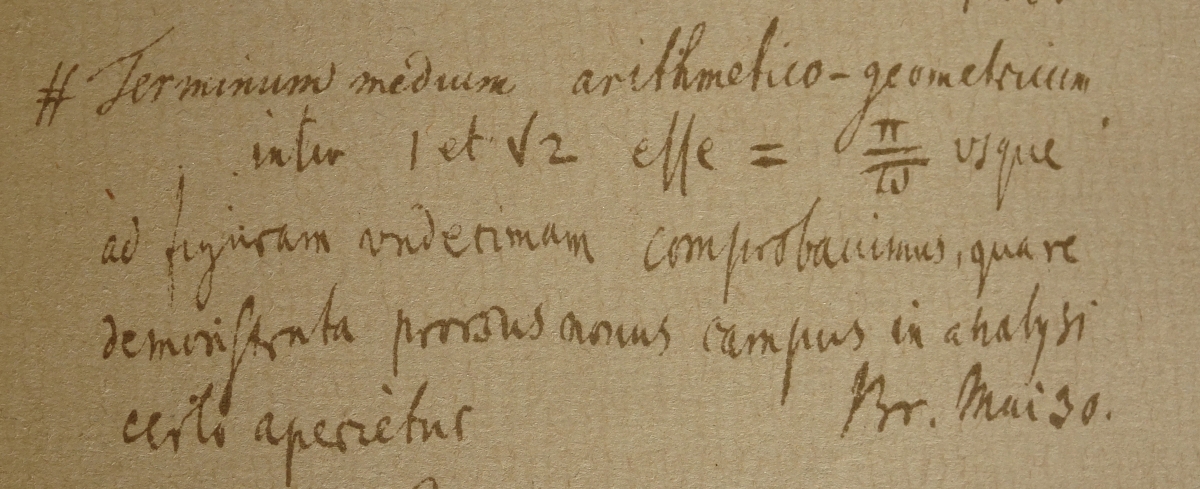- About MAA
- Membership
- MAA Publications
- Periodicals
- Blogs
- MAA Book Series
- MAA Press (an imprint of the AMS)
- MAA Notes
- MAA Reviews
- Mathematical Communication
- Information for Libraries
- Author Resources
- Advertise with MAA
- Meetings
- Competitions
- Programs
- Communities
- MAA Sections
- SIGMAA
- MAA Connect
- Students
- MAA Awards
- Awards Booklets
- Writing Awards
- Teaching Awards
- Service Awards
- Research Awards
- Lecture Awards
- Putnam Competition Individual and Team Winners
- D. E. Shaw Group AMC 8 Awards & Certificates
- Maryam Mirzakhani AMC 10 A Awards & Certificates
- Two Sigma AMC 10 B Awards & Certificates
- Jane Street AMC 12 A Awards & Certificates
- Akamai AMC 12 B Awards & Certificates
- High School Teachers
- News
You are here
Primary Source Projects and Reading Apprenticeship in Mathematics History: Routine #2 — Three-Column Reading Log for Gaussian Guesswork
In Janet Heine Barnett’s series of three mini-PSPs Gaussian Guesswork, students learn about results from Carl Friedrich Gauss’s (1777–1855) mathematical diary, including how infinite sequences are used to define the arithmetic-geometric mean. These PSPs are an excellent opportunity for students to read and make sense of Gauss’s original writing under the constraints of a short timeline and without study of advanced prerequisite material. We chose to use Gaussian Guesswork: The Arithmetic-Geometric Mean in this course.
We used a metacognitive reading log, which is an RA tool to help students make their own thinking explicit. Typically, a reading log prompts students to record important information and ideas in the first column and to write their thoughts, feelings, or questions in the second column (see downloadable resource for Metacognitive Reading Log). Because we anticipated students having prior knowledge of means, we used a three-column log in which students described their understanding prior to reading, their understanding after reading, and how they came to understanding. A sample student response is given in Table 1 below.
Table 1. Sample student response, metacognitive reading log for Gaussian Guesswork: The Arithmetic-Geometric Mean.
|
|
What I know |
What I know |
How I know it |
|
Arithmetic |
This gets used a lot in statistics and other everyday calculations. |
You add up all of your observations and then divide by the number of observations. |
I am very familiar with the arithmetic mean from previous classes. |
|
Geometric |
The geometric mean is another way of “averaging” a sequence of numbers. I don’t quite remember how it works but I believe the geometric mean is more resilient in terms of outliers. |
You multiply all of your observations and then take the nth root of their product. |
I remembered more about this from my statistics classes after reading the examples in the text. |
|
Arithmetic- |
The idea of combining arithmetic and geometric means is new to me. I’m guessing it is the difference between the two means. |
We start with numbers a and b and then construct two sequences whose values are the A.M. and G.M., respectively, of the previous entries in each of the sequences. Each sequence converges to the same value - that value is the A.G.M. |
There is an example given where we start with \(a=\sqrt{2}\) and b = 1. By the fourth term of the series, the numbers are identical to 20 decimal places. |
The student work sample presented in Table 1 gives insight as to what the student was thinking as she read. As expected, the student had a good understanding of the arithmetic mean. She noted that she has worked with it in other classes and accurately described how to calculate it. In the second row, she noted initially that she had encountered the geometric mean, but was not as clear on how it works (typically, about half of the students in this course will recognize the geometric mean and write a brief explanation in this first column). In the second column, the student accurately described how to calculate the geometric mean after reading. She noted in the final column that the reading helped her to remember more about it. This progression gives insight into the student’s prior knowledge and how well she has processed the information from the reading.
In the final row, the student noted that she had not previously encountered the arithmetic-geometric mean (AGM), which is typical for students in this mathematics history course. She gave a thoughtful (but incorrect) guess for how it is defined before reading. In the second column in this final row, she correctly described how to calculate the AGM after reading. She referenced the specific example from Gauss’s text of finding \(M(\sqrt{2},1)\). This is a particularly important example for this PSP, as the final section deals with Gauss’s conclusion:

Figure 8. Primary source excerpt from the PSP [Barnett 2017, p. 8].

Figure 9. Same excerpt in original Latin from facsimile copy of Gauss’ original diary
(from Volume X.1 of Gauss’ Werke).
Similar to the example given in Routine #1, the student’s work on this RA routine shows that she was prepared to tackle the more challenging tasks in the PSP. In general, this routine also draws on the students’ previous experiences as they acquire new knowledge through reading.
Jennifer Clinkenbeard (California State University, Monterey Bay), "Primary Source Projects and Reading Apprenticeship in Mathematics History: Routine #2 — Three-Column Reading Log for Gaussian Guesswork," Convergence (November 2023)




